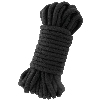Shibari: Everything you need to know
Publicado: 2025-10-17 14:15:42
Categorias: ,

Shibari is an art form with a rich history and a fun, experimental present. Shibari, or Japanese rope bondage, is a style of kink or BDSM play that comes from Japan. It originated as an underground form of culturally specific erotic fantasy, centered on erotic nostalgia for bygone eras. Just as eccentric people of European heritage incorporated legends and tools of medieval European incarceration – such as handcuffs and the St. Andrew's Cross – into their sexual shadow games, the Japanese found carnal inspiration in historical fables of their captured maidens and imprisoned heroes. In Europe, non-consensual incarceration often used metal and leather, while in Japan it was often done with rope.
Today in Japan, shibari is enjoyed by consenting adults in their private sex lives, in performances at themed bars, and, of course, in pornography. Who is shibari for? Any consenting adult. Japanese rope bondage can be enjoyed by lovers, friends with kinky benefits and individual pleasures with yourself.
What are the roles like in Shibari?
There is a person who casts the ropes, which means he is tying. The other person is the one who receives the strings. They put the rope on the body. Those who master the experience are those who cast the ropes, while those who receive them follow the instructions.
Often, the chosen person is also dominant and the receiving person is submissive. But you can also be the one who directs and dominates the other to tie him as he wants to be tied; this would fall under the heading of dominant masochist. The submissive partner who follows directions and ties up the other can be called a submissive-sadist.
Let's not forget individual pleasures: you can get tied up just because it feels good or enhances your fantasy life. Everyone who is participating with fully engaged and collaborative consent. This is important. What people get from shibari play - physically, emotionally, and sensually - varies enormously and widely. There are as many pleasures as there are people who enjoy shibari. But here are a few:
- Play the role of the mischievous “villain”.
- Delighting in the fact that your partner is able to let go and feel pleasure.
- A feeling of joy.
- Good sexual positions.
- Feeling emotionally connected.
The recipient can enjoy:
- Being able to let go emotionally and physically.
- The feel of the rope and/or the feeling of tightness.
- The potential to improve sensual perceptions and/or orgasms.
- Representation of roles such as “snatched”.
- Sex positions that are easier to maintain when the ropes are supporting you.
- Feeling emotionally connected.
How to choose your equipment for Shibari?
Safety ropes and scissors are the basics. Everything beyond that is a bonus. One of the delights of rope and shibari is that you don't need much to get started. Of course, some people really enjoy purchasing a lot of sophisticated equipment, just like in any leisure and pleasure activity. But shibari doesn't require you to have expensive ropes made from hemp, jute or other fibers.
For a warm and easy game for beginners, I recommend starting with a nice soft cotton shibari rope. Why cotton and not sophisticated materials like jute or hemp? It's soft on the skin, holds knots well, hardly irritates allergies, and is easy to wash after sexy, messy fun. Cotton is also good for a budget: because it's cheap, you can buy a lot of it and wear it without feeling precious or overly delicate. It is easier to shorten it to the desired length or cut it in case of emergency. I want people to play without stressing out.
Preparation and planning for Shibari
Pre-game talk. Make sure you talk about what you both want and don't want, and then figure out your shared desires. Both parties establish their limits and respect them. How will each of you let the other know that you are having fun or if you need to change or stop something? Let the other know clearly. Establish a safe word as well.
Pre-plan each of your aftercare needs. After the fun of shibari, whether the play was fantastic or not, people often need their own transition time. This period of brilliance is necessary to convert a good moment into a fantastic memory.
Start with shorter ropes as they are easier to handle. Super long ropes can get tangled and only increase the frustration of the person tying and the boredom of those waiting to be tied.
Safety scissors. Always have a set nearby when playing. Sometimes the knots simply get too tight or a person needs to get out quickly for whatever reason.
Basic Shibari Positions
A simple idea to try, especially if it's your first time: start with your favorite sexual position and use the ropes to tie the receiving partner in that way. Another simple position: Tie your right wrist to your right thigh and your left wrist to your left thigh. If the receiving partner is a little more flexible, try from the wrists to the ankles.
If parts of your body feel tingling, change position and see if it returns to normal. Signs that something is not going well and you should use your safety scissors: The ropes are so tight that you feel a tingling sensation or the color, texture or normal temperature of the skin changes drastically.
The real key is not the bonds or knots, but the connection between partners, the flow of play, and your ability to improvise to co-create joy.
What is the difference between Bondage and Shibari?
Bondage, in general, can use any type of restraint – handcuffs, tape, ties, scarves, etc. – but shibari exclusively refers to the practice of using rope, or rope-like material, to tie yourself or your partner together. Shibari is not just about the feeling of restriction, but also about the intimate connection between the one tying and the one being tied.
And although rope bondage is commonly used in BDSM practices, shibari stands out for its striking visual aesthetic and emphasis on the emotional and psychological connection between participants.
Why should my partner and I try shibari instead of regular bondage?
All BDSM practices require high levels of trust and communication, but for shibari, there is sometimes a more intimate and emotionally binding component. The feeling of being tied down is not the feeling of being 'trapped', but rather lends itself to the idea of completely letting go of physical boundaries and allowing this deep emotional catharsis to happen.
The play between power dynamics and the release of bottom-up control creates an intimate dance of trust and connection between partners. This often creates a deep emotional connection, sometimes felt as crying, euphoria, or simply a sense of deeper connection.
Tips, tricks or benefits of trying shibari?
Sales will make everything significantly more fun. This takes the pressure off the new adventurer and increases the feeling of being tied down.
Keep things simple and sexy. There is no need to overcomplicate the ties.
Also enjoy the untying part – don't just focus on the aesthetics of tying up your partner. Don't be in a rush to savor it - this is often when the skin and body are really awake to sensuality.















